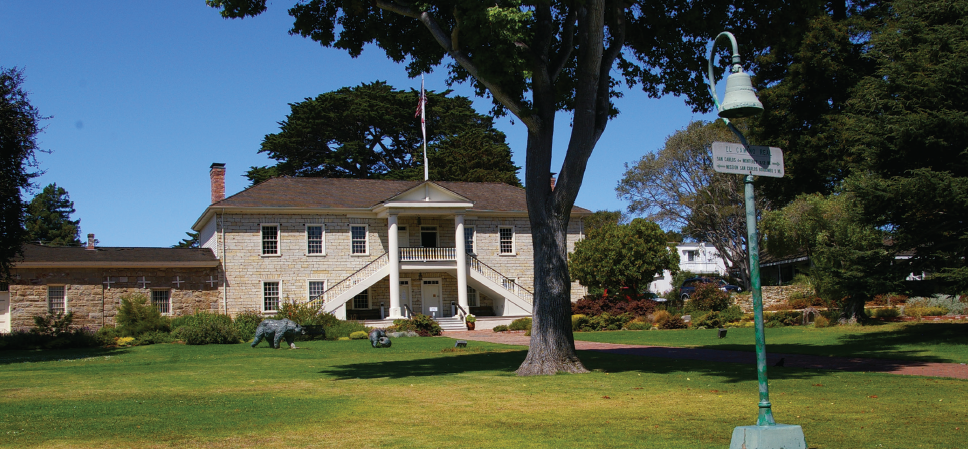To the casual passerby of Friendly Plaza in old town Monterey, it’s just a large pine tree. But the tall redwood is actually a “moon tree” one of nearly 500 seeds from five species carried by Apollo astronaut Stuart Roosa on the 1971 Apollo 14 mission.
Adjacent to Colton Hall Museum, where the California Constitution was conceived and signed more than 150 years ago, the two points of history combine to make a perfect “hidden gem” that few people know about.
Seeds in Space
Roosa was orbiting the moon in the command module while Alan Shepard was on the surface, and spent 33 hours alone, completing 34 orbits. One of his goals was to determine if seeds exposed to cosmic radiation would grow differently on earth. Subsequently, some of the seeds were germinated side by side with normal earth-bound seeds; no differences were seen.
But the mystique remains that the seed was “out of this world,” albeit a little known part of lunar science history. Most of the seeds were given away between 1975 and 1976, corresponding to the nation’s bicentennial. Today Roosa’s “moon trees” are growing all over the United States, including the White House, as well as Japan, Brazil, and Switzerland. The first moon tree planted was a Sycamore seedling near Independence Hall in Philadelphia, Pennsylvania on May 6, 1975. Where all the seeds were planted is not known, but a partial list is available at nssdc.gsfc.nasa.gov/planetary/lunar/moon_tree.html.
A commemorative brass plaque identifies the Moon tree, one of a variety of trees and plants living in Friendly Plaza, in itself a pleasant place to sit and relax. The tree is surprisingly short (for a redwood). As I gazed up through the bushy dark-needled branches, I confess I wondered if that’s due to its space trip. Perhaps the differences engendered by space travel take time to manifest themselves?
A Constitution Ahead of Its Time
Extremely close by sits Colton Hall Museum, a white stone building guarded by a statue of a grizzly mother and her cubs. At the time of its construction, it was considered one of the preeminent architectural buildings in California. It’s named after the Reverend Walter Colton, appointed as the first American Alcalde or Chief Magistrate of the Monterey district.
It was originally built during the ‘Early America’ period as both a town meeting hall and public school in what was once California’s capitol. Then, in 1849, during the height of the Gold Rush, a convention was called to craft a Constitution that set some surprising precedents. The massive influx of people and disruption of the old way of life for existing residents raised great concern. Nobody knew how long the Gold Rush would last, but forward-thinking people knew clearly defined parameters were needed, and met to lay the groundwork for concepts still in effect today.
The Museum has carefully recreated the meeting room and the Convention with artifacts, documents, maps and paintings that pull visitors back in time – while revealing the humanity of creating such a document. Inkwells and quill pens and parchments, old books and more lay upon the long tables. Spittoons squat near the fireplace. Chandeliers that once held candles dangle overhead. In one case you can see the original ‘registration in’ list, where all delegates signed in – the penmanship is superb. According to the very knowledgeable docent that answered my barrage of questions, the replica painting of George Washington had been put in the Hall because the delegates felt that having the nation’s first president overlooking the proceedings brought a sense of history and gravitas.
Between September 1 and October 13, 48 delegates elected from 10 districts met and debated a host of issues, ranging from determining California’s eastern boundary and its new capitol (San Jose), to forbidding slavery and putting into place rights for women. Our docent shared that the Constitution was bilingual, and also addressed issues pertaining to Mexican landowners and Native Americans – all concepts well ahead of their time.
Right next to the Museum is the Old Monterey Jail, well worth a visit. Constructed in 1854, it was used for over a century, shuttering in 1956. The iron-girded tiny cells and history placards reveal intriguing period insights – and a shiver at imagining being stuck inside them for years.
On your next visit to Monterey, take a detour to enjoy this little slice of history. The museum is currently open from 10 a.m. to 4 p.m. Saturday and Sunday and is free of charge; donations are accepted. A museum attendant is available for tours and information. Learn more at www.monterey.org/city_facilities/museums/discover_museums/colton_hall_museum.php.





